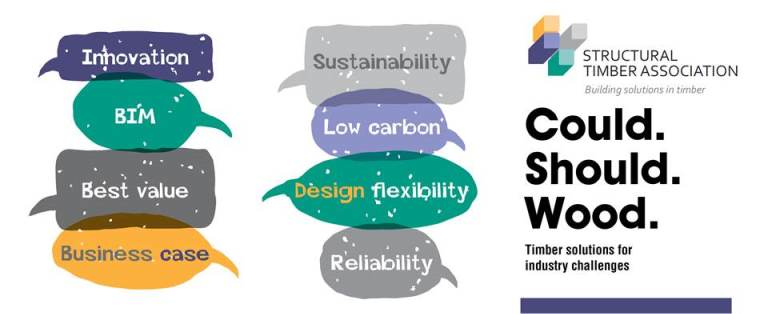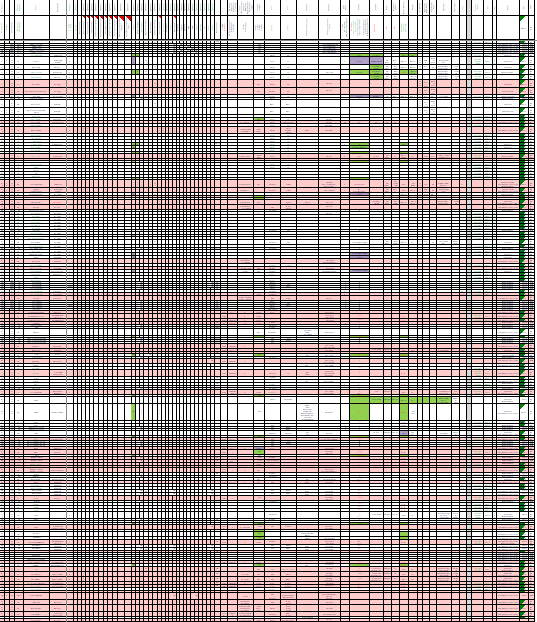GBE > Encyclopaedia > Code > Checklist > New Build > G#1597 N#1527
G20 Carpentry/Timber Framing/First Fixing Checklist
G20 Carpentry/Timber Framing/First Fixing Checklist
About:
Index:
Problems:
- Tree cutting is seasonal:
- unseasoned hardwood framed buildings:
- be aware of the potential for delay until next tree cutting occurs,
- plan projects around this issue
- Acidic species:
- tanning run off can stain porous materials below,
- provide temporary or sacrificial protective materials or coatings
- can corrode or stain ferrous metal fasteners or visa versa
- use austenitic stainless steel fasteners (screws/nails etc.)
Misunderstandings:
- Durable timbers do not all come from the Tropical Rain Forests
- There are durable softwoods as well as hardwoods
- Prefabrication off site does not reduce offcuts,
- but the off cuts have a greater potential to be used in a factory rather than put in a skip on site
Solutions:
- Grow trees to be available to replace roof and other timbers in 60-120 years
- Use any existing trees that are to be cut down as part of the works
Consider:
- Choose locally sourced timber:
- first > last:
- Site > Town > County > Region > Country > Continent > World
- FSC certified forest timber,
- it addresses more of the sustainability issues,
- 276 sources in the UK.
- Oak and many other species are durable and are available in the UK and Europe
- Off site prefabrication to reduce on site waste
- Design structure for appropriate life See A90
- Short life: 30 years
- Normal Life: 60 years
- Long life: 120 years:
- Design frame for deconstruction, salvage and reuse in future at end of design life. See A90
- Softwood or Hardwood in place of steel structure
- Floor structure, roof frame, decking and ramps are opportunities for timber structures made from home-grown structural timber, reducing the need for cement and aggregates on the project
- Glued laminated timber where poor strength grade timber can be substituted in the middle of the section where it is least stressed
- Potential to reduce the self weight of the section without significant loss of strength
- Use of prefabricated pre-insulated breathing wall, floor and roof panels
- Timber structure in place of concrete
- to avoid temporary formwork materials (plywood and softwood) used in formwork,
- potentially used a few times then thrown away to landfill as waste
Avoid:
- Wood substitutes: unless it is 100% recycled plastic
- Cradle to Cradle:
- avoid blending natural (wood fibre, wood flour) and technical (plastic binder)
- ingredients that cannot be separated at end of life,
- Proviso: unless the manufacturer:
- leases the product to the user,
- has a tack back scheme in place,
- is already recycling their own post consumer product
- Cradle to Cradle:
- Illegally forested timber
- (Use EUTR procedures)
- Non-sustainably managed forested timber
- Tropical Rainforest timbers,
- (there are probably other species which will do the job you need from nearer the site)
- Endangered species of timber,
- (Check the CITIES website)
- See GBE SPECIES TABLE
- Clear felled virgin forest timber
- Clear felled plantations if not replanted
- Indonesian Hardwood,
- most is reported to be illegally logged:
- destroys forests, communities and habitation
- Adhesives if fasteners will do the job required
- Burning timber off cuts on site
Minimise:
- PEFC certified forest timber, it does not address all the sustainability issues adequately, choose FSC first
- Synthetic adhesives if natural alternatives can do the job required
Substitute:
- Specify by performance requirement then the suppliers can choose available FSC species to do the job required and offer a range of colours close to your requirements
Health:
- Avoid formaldehyde adhesives in boards, compound or laminated sections See Z20
Wellbeing:
- Use planed and arrised softwood sections to minimize splinters whilst handling sections
Safety:
- Normal manual handling and mechanical handling safety measures
- Bulk timber is heavy and has momentum at the end of a sling from a crane
Precautionary principle:
- Use a sacrificial coatings during handling and installation
- Sand off all sacrificial coatings prior to hand over leaving in pristine condition
Resource Efficiency Issues:
Reduce:
- Use compound I section timbers, in place of solid sections:
- reduces use of timber, resource use reduction
- reduces fuel to transport
- easier to handle on site, often by just one person
Reclaim:
- All healthy timber that can be reused
Reuse:
- Second hand timber
- FSC now recognises reuse of timber
- Salvaged timber from existing building in:
- Softwood in stud walls, floors or roofs
- Floor boarding
- Doors, Windows
Recycle:
- Damaged untreated timber
- Make bat and bird boxes with offcuts
- Use as mulch in landscape
Recover:
- Nutrients from untreated timber by composting
- Energy from timber offcuts by saving in a biomass fuel store for use in the employer’s biomass boiler
Waste Issues:
Hazardous waste & Deleterious Substances:
- Preservative treated timber is hazardous
- Do not use preservative treated timber in bat and bird boxes
- Do not use preservative treated timber in childrens toys
- Do not use preservative treated timber in food growing planters, raised beds
- Preservative treated timber is potentially inert in landfill, but leaching may occur
Waste statistics
- 30 m tonnes (33% of 90 m. tonnes/year) of waste is offcuts (not all timber)
- 9.4 m tonnes (10.2% of 90 m. tonnes/year) of waste is Temporary works, Site hoardings and Formwork
Waste minimisation:
End of Life options:
- Dismantle for reuse (build it with the right fasteners)
- Choose durable species
Appropriateness:
- off site prefabrication to reduce waste:
- Use of prefabricated pre-insulated breathing wall, floor and roof panels
Competence:
- Reclaimed timber for reuse:
- check suitability for use in structural application
- there are 900 timber strength graders in UK
- some structural engineers will assess timbers for reuse
- Choose species with the right properties for the job
- Don’t choose your favorite coloured species for every application
- Don’t choose your favorite coloured species for external applications the colour will fade to silver or grey
Effectiveness:
- Steel sections can be smaller than timber to meet structural requirements
- If fire resistance is required steel sections get considerably bigger than timber
- Encasing steel or applying intumescent paint increases cost and environmental impact
- Timber sequesters carbon from the atmosphere so reduced atmospheric carbon now
- Timber buildings can be carbon negative
Yardstick:
- A standard is being developed to permit embodied carbon and sequestered carbon to be taken into account in Total Carbon calculations for buildings
Maintenance issue:
- Untreated unseasoned unfinished durable species timber need no decoration and need no maintenance of that decoration
Information sources:
- The Wood Explorer(USA, part free, mostly paid for access, via apps)
- A massive knowledge-based site featuring 1648 tree species.
- TRADA
- askTRADA
© GBE NGS ASWS BrianMurphy
aka BrianSpecMan
2008 – 25th July 2014 – 15th February 2018
G20 Carpentry/Timber Framing/First Fixing Checklist
Images:

© Structural Timber Association

© Solid Wood Solutions


GBE DataSet
GBE Timber Species (Dataset) G#1371 N#1351
Avoid using the species in the pink rows

GBE CPD
If you wish to reproduce images, feel free, but please acknowledge the source.
© GBE NGS ASWS BrianMurphy
aka BrianSpecMan
25th July 2014 – 15th February 2018
G20 Carpentry/Timber Framing/First Fixing Checklist
See Also:
GBE JARGON BUSTER
- Term
GBE CPD
- Seminar
GBE CHECKLIST
- Trade
GBE LINKS
- TRADA
- askTRADA
GBE MANUFACTURERS
GBE PRODUCTS
GBE MATERIALS
GBE SYSTEMS
GBE ELEMENTAL ASSEMBLIES
GBE CALCULATOR
- Product
GBE DATA
GBE CAD
- 2D and 3D SketchUp Product files
- SketchUp files of Construction Sections
GBE GREEN BUILDING SPECIFICATION
GBE PROJECTS
© GBE NGS ASWS BrianMurphy
aka BrianSpecMan
25th July 2014 – 15th February 2018

